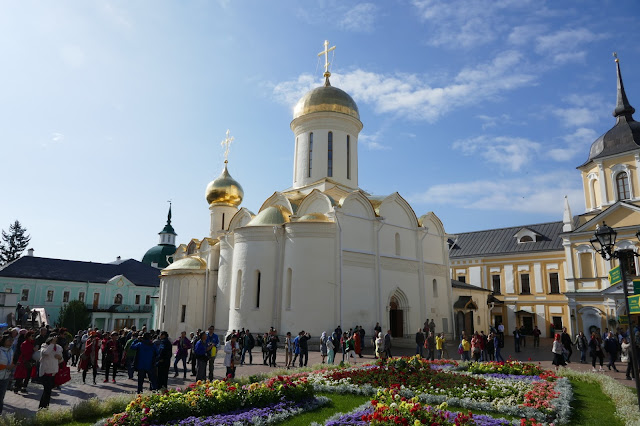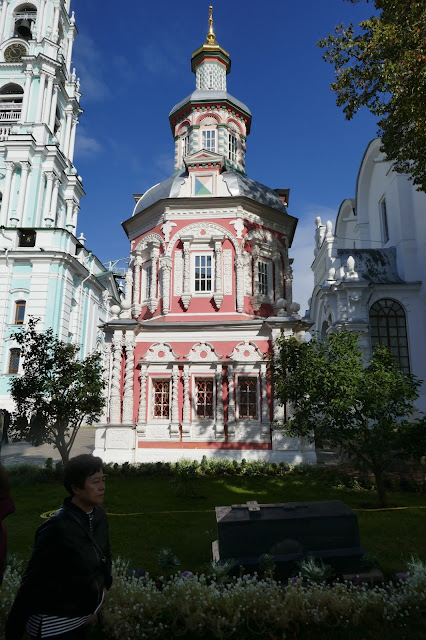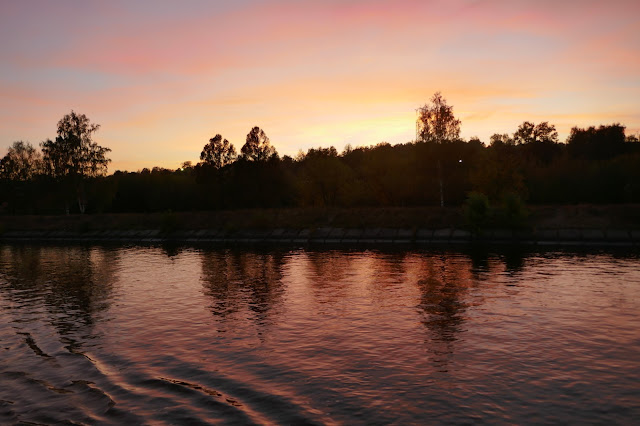After a long day of travelling through Heathrow and Amsterdam, we are finally arrived at our boat and were ready to rock and roll. Connie and Dennis came all the way from Seattle in shot!
My plan in the next 3 postings is for post 1 to show you our 3 days in Moscow, post 2 is the boat trip upstream to St. Petersburg documenting the several villages along the way, and post 3 shows you our 3 days in St. Petersburg.
The cruise itself began in Moscow and ended in St. Petersburg on what is called the Moscow-Volga waterway. You can see (on the map below) that the Volga River does not go through Moscow, but rather begins northwest of Lake Onega and flows south and east to the Caspian Sea. Moscow was connected to the Volga via the Moscow Canal.
To the right in the previous picture, you can see the State Historical Museum. Russia has innumerable museums (since many of the churches were turned into museums), but this is Russia's main museum. Completed in 1883, the history of Russia is represented from the oldest days to the beginning of the 20th century. Behind the museum and up a small hill is the our access to Red Square below.
Every town in Russia has a Red Square as the old Russian word for Red means 'beautiful'. The Red Square in Moscow is surrounded by famous structures on all sides. On the north side is the Museum; on the South side is St. Basil's Cathedral, which is really 10 cathedrals built together (but which now is a museum); the high-priced G.U.M. stores lines the east side of Red Square; and the walls of the Kremlin border the west side of the Square. Here we are standing in the middle of Red Square in front of St. Basil's Cathedral.
The Kremlin itself was our next destination. It is a huge complex, nearly 3 km square. It is the symbol of both Russian and Soviet power and authority and it has served as the official residence of the president of the Russian Federation since 1991. On the outside of the west wall of the Kremlin is Lenin's tomb, which was not open for visiting hours when we were there. Next to it was Stalin's tomb, but after Nikita Khrushchev blew the whistle on Stalin's murderous past, Stalin's tomb was down-sized and buried in the backyard. On the outside of the north wall is Moscow's tomb of the Unknown Soldier, formally guarded, as are comparable tombs around the world.
Here the guard stands for hours.
When we went through the Tower to the inside, we could see the thickness of the walls, which ranges from 11 to 21 feet. The guy in the red jacket is Dennis.
As we entered into the Kremlin proper on the other side of the tower, we were at the Napoleon exhibition in front of the Armory Building. Napoleon came to Russia in 1812 with the expectation of 'conquering' Moscow. Napoleon originally headed across Russia to defeat Tsar Alexander I with 685,000 soldiers. There were several disastrous battles on the way to Moscow, one of which killed 72,000 of the troops in one day. When he arrived, however, the city had been evacuated of people and supplies, so there was no one to conquer. Napoleon expected the Tsar to sue for peace, but when he got to Moscow he found that the Russian army had retreated and there were no czarist officials to sue for peace. He stayed on the outskirts overnight, and around midnight fires broke out across the city, apparently set by Russian patriots leaving nothing for the remainder of Napoleon's army (400,000). Because there were no supplies for the coming winter, he left Moscow one week later with less than 400,00 troops, and returned to France, suffering from the 'burned earth' campaign he had initiated on his way into Russia. This campaign was a disaster for Napoleon, leading to the end of the Napoleonic Wars. He left 865 cannons, and the some of the barrels are on display in front of the Armory, which was rebuilt in 1816 and dedicated to the victory of Russia over Napoleon.
Closer examination of the barrels reveals that they are all decorated and marked with an N for Napoleon.
Also on display are several of the Russian cannons. They are very articulate and apparently the Russians are very proud of them -- as they should be.
From here we went into the gardens to see green things and flowers.
There were many extensive flower beds outside the Kremlin walls and walkways through the gardens, the Alexander gardens, named after Tsar Alexander, who order the gardens construction after the Napoleonic wars destroyed everything in the areas where the new gardens were planted.
Then we came to Cathedral Square in the Kremlin. This is the Cathedral of the Archangel (completed in 1508), where victories of the Russian Military were celebrated. All Russian tsars and grand princes were buried within this Cathedral until the time of Peter the Great, along with many empresses and princes of the blood line.
|
|
The Annunciation Cathedral is attached to the Patriarch's Palace, which can be seen behind it. This cathedral became the burial place for Moscow Metropolitans and Patriarchs of the church from 1547 to 1896. It held the personal chapel for Muscovite czars. Although we got our first peek at Russian Orthodox iconography in this church, we were not allowed to take pictures of them. In Russian churches, the nave is separated from the sanctuary by an iconostasis, or icon screen (a wall of icons with double doors in the centre). Icons are the 'soul of Russia'. They first appeared in 988, when the Rus' converted to Orthodox Christianity. They typically were paint on wood. Icons are considered to be the Gospel in paint and, therefore, careful attention is paid to ensure the Gospel is accurately conveyed.
Day 2 - We were bussed the next morning to the Trinity Lavra Monastery. Founded by St. Sergius in 1337, it is the holiest place in Russia. It was the seat of the Moscow Patriarchate until 1983, although it was closed during the early communist years (1917 to 1946) and its buildings were all turned into offices and museums. In the foreground is a large statue of St. Sergius. The monastery is built within high walls, and you can see here the two tallest structures in the lavra: its Bell Tower and its Assumption Cathedral.
The crowded entry for tourists was through the Church of the Nativity of St. John the Baptist also called the Gateway Church.
The bell tower, or Pilgrim Tower, built between 1741 and 1776, once had 42 bells, the largest of which weighed 65 tons. This 5-tier tower took 30 years to build and is even higher than the bell tower in the Kremlin. After the revolution, all of the bells in this tower were destroyed, and pieces of bronze were used for other projects in Russia.
Finally were back at the boat to relaxed and review our day on our pleasant balcony on the Rurik.
Our 3rd and final day in Moscow began with another bus ride across town. Not sure which bridge this is, but there are 49 bridges across the Moscova River in Moscow.
One of the first structures we saw was easily recognized as the back of St. Basel's cathedral along the boundary of Red Square.
We continued on the road between the wall of the Kremlin and the Moscow River.
We rode past many towers along the wall.
|
|
The tour brought us ultimately to a statue of Peter the Great on a ship, which was positioned out in the Moskova River. Apparently many Muscovites are not fans of Peter because, among other things, he moved the capital from Moscow to St. Petersburg back in 1703. There have been many petitions to remove this statue, one of the 'ugliest in the world', but the cost has made it prohibitive. Vindictive!
At a higher power you can better see the Peter part of the memorial.
The main reason for being in this general location was to investigate the rebuilt Cathedral of Christ the Savior. We stopped here for some time to visit the Cathedral. This was the largest church in the Orthodox Russian Empire. It was built in 1883. During Lenin's time, it was closed and the property confiscated and thousands of clergy shot. Many churches became storage spaces, movie theaters, libraries, etc. Because of its central location, Stalin planned to replace this cathedral with a Soviet Palace, so he blew it up in 1931. His plan came to an end with the German invasion in 1941. After the war, the space was used to build a huge open-air heated swimming pool twice the size of a soccer field. Many older Moscow citizens remember learning to swim in that pool. As Putin searched for a new identity for the USSR, the Russian Orthodox Church was no longer 'an enemy of the State', but rather, experienced a revival. The ROC now plays a decisive role in the renovation of cathedrals and monasteries throughout Russia. Government funding has been used for many projects, but the reconstruction the Cathedral of Christ the Savior was financed entirely with donations of more than a million citizens of Moscow. It is a perfect replica of the original church built on the original location.
We spent quite some time here and approached it from the front.
And closer still. Note all the bronze decorative art above and adjacent to the doors
Here are two pictures of a couple of the art pieces.
And a second one.
And a close up of the elaborately decorated doors.
After returning to the bus, we saw that one building across the street was described as under construction (and covered with a protective fabric). We were told that this building or one like it housed the many dissidents of Stalin -- before they all 'disappeared'. As I mentioned earlier, it was Khrushchev that blew the whistle on Stalin after his death and explained to the government how many millions of citizens he had disposed of.
Following this adventure, we headed to the subway system. It is located several hundred feet underground and is immaculate. The Moscow metro was built for two purposes: first, for transporting the population more efficiently because the street traffic was becoming almost prohibitive (currently, a daily commute by car takes up to two and a half hours each way across town); and second, because Russia was preparing for a possible war. Officials' offices were planned for the underground space. Throughout this system, the walls are covered with artwork. Every pillar has a picture of life in Russia. The art in each station is dedicated to a different theme of Russian life or history. Here are several examples.
And closer views of other pictures.
And another.
We exited via the Pobedy (Victory) Station. This is the deepest station. Access to all stations is by way of an escalator system. When building of the subway was started, it was discovered that the ground was significantly unstable due to underground rivers, so it was built much lower than most subway systems. This is decorated in noueveau art style and the lowest station, is lowest, and has one of the longest elevators anywhere.
The theme continues up the escalator system to street level.
and ends at street level.Finally the old Soviet symbol is at the apex of the ceiling above the escalator entrance.
Thus our days in Moscow were over and we began our journey upstream on the Moscow canal heading to the Volga, visiting Yaroslavl and various small towns on our way to St. Petersburg. This portion of the trip will form the next post entitled Russia-2. Note the small waves to the west created by the ship under power. Usually, the travelling was done at night so that we could be at the next stopping point before dawn.
See you again soon.

















































































